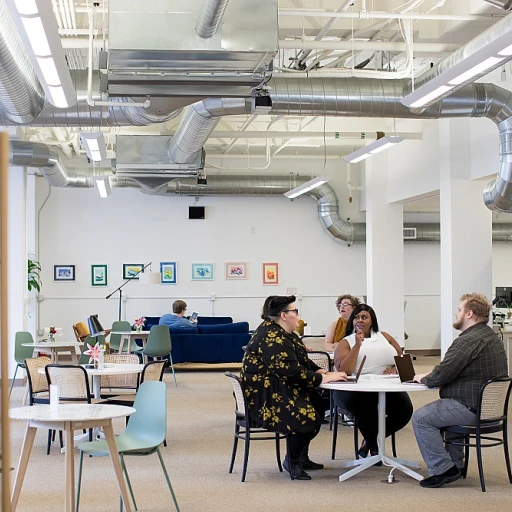The Challenge of Balancing Work and Life
The Struggle to Maintain Harmony
In today's fast-paced world, finding an equilibrium between professional duties and personal life is more challenging than ever, especially for those in high-stress jobs. Whether you are an executive, healthcare professional, or educator, the pressure to perform has dramatically increased. This struggle is not only a personal battle but also a societal challenge as more individuals report experiencing burnout and dissatisfaction.
The key issue facing many professionals is the blurring of lines between work and personal life. With technology enabling constant connectivity, the traditional 9-to-5 workday seems obsolete, often morphing into 24/7 availability. This constant tethering to work responsibilities can lead to decreased time spent with family, neglected hobbies, and a lack of personal downtime essential for recharging.
Although the rewards of high-stress roles can be significant—such as job satisfaction, financial stability, and career advancement—the personal sacrifices are equally notable. This imbalance not only affects individuals but also impacts organizations and society as a whole. Thus, the imperative to balance work and life becomes more urgent.
Understanding the challenge of maintaining this balance is crucial in addressing the broader impacts on well-being and health, which we will explore further, alongside potential strategies to manage these stressors effectively.
Impact of Stress on Mental and Physical Health
The Detrimental Effects of Stress on Well-being
In today's fast-paced world, the demands of high-stress jobs often seep into the personal lives of employees, blurring the lines between work and home. This encroachment can significantly affect mental and physical health, laying a heavy burden on those striving for a harmonious work-life balance.
The mental health implications of chronic stress are well-documented. Prolonged exposure to intensive work scenarios can lead to anxiety, depression, and burnout. Employees in high-stress roles often find themselves caught in a cycle where stressors from work trigger mental health issues, which in turn complicates the ability to perform effectively in their roles and maintain personal relationships.
Physically, stress is just as damaging. It can manifest through symptoms like headaches, insomnia, hypertension, and weakened immune response. The pressure to meet deadlines or achieve targets can push employees to overlook self-care, skip meals, or neglect exercise, further deteriorating their health.
Aside from individual health, the repercussions of stress extend to professional settings too. When employees are overstressed, their overall productivity and creativity might decline, which could lead to an increase in absenteeism and even attrition. Addressing these challenges is crucial for both the workforce and employers, creating a need for effective strategies and support systems.
Exploring ways to manage or mitigate stress requires a holistic approach that considers not only professional requirements but personal well-being too. As we delve further into strategies for achieving a more balanced work-life dynamic, we must recognize the gravity of these health impacts and prioritize interventions that support individuals in high-pressure environments.
Strategies for Achieving Better Work-Life Balance
Effective Approaches to Enhance Work-Life Synergy
Balancing work and personal life can often feel like a delicate juggling act, particularly when dealing with high-pressure roles. In our previous sections, we discussed the significant toll stress can take on both mental and physical health, emphasizing the urgency of crafting effective strategies that promote work-life harmony.
One of the most effective ways to achieve equilibrium is by setting clear boundaries. This involves delineating specific times for work and personal activities. For example, unplugging from work emails and calls during personal hours can reduce the overlap that exacerbates stress and blurs the lines between professional and private spheres.
Time management is another crucial strategy. Prioritizing tasks and setting realistic goals can help prevent burnout in high-stress roles. By integrating techniques such as the Pomodoro Technique or time-blocking, individuals can manage their workload more effectively, allowing for breaks and leisure activities that promote relaxation.
Moreover, incorporating regular physical activity and mindfulness practices into daily routines can significantly enhance one's ability to handle stress. Exercise releases endorphins, which naturally elevate mood and improve overall well-being. Mindfulness practices such as yoga and meditation not only aid in reducing stress but also increase awareness and concentration, better equipping individuals to handle work-related pressures.
Additionally, tapping into available resources like employee assistance programs or company-provided wellness initiatives can offer valuable support. Many organizations today are implementing programs that make a difference by promoting holistic employee well-being. Engaging in these initiatives can offer tools and support to manage stress effectively.
Ultimately, the key to achieving better work-life balance lies in understanding that it's a dynamic process that requires regular reassessment and adaptation. By integrating these strategies, individuals can work towards a healthier, more balanced lifestyle even in the most demanding roles.
The Role of Employers in Supporting Work-Life Balance
Employers' Influence on Work-Life Harmony
When it comes to managing work-life balance in high-stress roles, the role of employers cannot be underestimated. Organizations have a significant influence over how their employees manage the delicate dance between professional demands and personal responsibilities. By fostering a supportive environment, companies can play a crucial role in alleviating the adverse effects of stress covered earlier.
To begin with, providing flexible work arrangements is a pivotal strategy that employers can adopt. Flexibility allows workers to adjust their schedules to better accommodate their personal lives, which in turn can reduce stress and improve overall job satisfaction. This could include options like remote work, flexible hours, or compressed workweeks. Addressing the challenges of balancing work and life becomes more feasible when employers trust their employees to manage their own schedules effectively.
Moreover, implementing wellness programs can significantly benefit employees' mental and physical health, which is often impacted by high-stress jobs. Employers can introduce resources like mental health days, in-office wellness facilities, and access to counseling services. Such programs signal to employees that their well-being is paramount, potentially leading to enhanced productivity and reduced absenteeism.
Investing in robust communication and support systems is another essential strategy. Employers should foster an open dialogue with their employees, encouraging them to voice their concerns and providing feedback. This transparency not only helps in identifying stress triggers but also aids in developing personalized work-life balance solutions.
Furthermore, training managers to recognize and support the unique work-life balance needs of their team members can have a significant impact. Managers play a crucial role in creating a work environment that prioritizes well-being, and they must be equipped with the skills to promote balance and address any issues promptly.
In conclusion, while achieving a perfect work-life balance may be an ongoing challenge, employers have the opportunity to lead the way in creating an environment where employees feel valued and supported. By prioritizing work-life harmony, organizations can create a more engaged, loyal, and motivated workforce. Moving forward, the cultural perspectives discussed previously will continue to influence how employers adapt their strategies in a post-COVID world.
Cultural Perspectives on Work-Life Balance
Cultural Views on Harmonizing Work and Personal Life
In exploring the landscape of work-life balance, it's imperative to recognize that cultural perspectives significantly influence how individuals and organizations approach this equilibrium. Across the globe, diverse cultural norms shape expectations regarding work hours, lifestyle choices, and familial responsibilities.
For instance, in countries like Japan and South Korea, long working hours have historically been the norm, deeply ingrained in the cultures as a sign of dedication and commitment. However, growing awareness of the detrimental impact of stress on both mental and physical health, as discussed earlier, has led to gradual cultural shifts and movements advocating for better work-life balance. The government and many companies are starting to realize the importance of addressing these issues to protect the well-being of their workforce.
Conversely, Scandinavian countries, such as Sweden and Denmark, are often lauded for their progressive attitudes towards work-life balance. Emphasizing shorter workweeks and generous parental leave policies, they have set high standards in prioritizing employees' quality of life. This approach not only enhances employee satisfaction but also boosts productivity, guiding other nations to re-evaluate their own work culture.
In the United States, there is a noticeable trend towards a more balanced approach, with increasing numbers of organizations offering flexible work schedules and remote working opportunities. However, the cultural attitude towards distinguishing professional success often remains tied to long hours and availability, making it challenging to break away from the constant connectivity mindset.
Theoretically, as discussed in previous sections, developing strategies to manage work-life balance is crucial. However, the success of these strategies is often contingent upon societal views and corporate policies that either support or hinder these efforts. As globalization continues to blur borders, a blend of multicultural insights might pave the way for a more universally accepted model of work-life harmony.
Ultimately, understanding and respecting cultural differences are essential for creating adaptable and inclusive work environments. As organizations continue to learn from one another, there is hope for a future where varied perspectives on work-life balance can be integrated, leading to workplaces that not only accommodate, but celebrate diverse working practices.
The Future of Work-Life Balance Post-COVID
### Adapting Work-Life Balance Strategies for the Post-Pandemic Era
As we navigate the waters of a post-COVID world, the notion of work-life balance has undergone significant transformation. The pandemic has acted as a catalyst, challenging previously held norms and accelerating shifts in how work is perceived and conducted. Remote work and flexible schedules have become more commonplace, prompting both employees and employers to rethink conventional work-life strategies.
The necessity for change became apparent as many workers found themselves confined to home offices, blurring the lines between professional responsibilities and personal life. This shift highlighted the importance of effective management of work and life pressures, echoing the challenges addressed earlier. Remote work, albeit flexible, sometimes increased stress as individuals grappled with creating boundaries in their living environments, affecting both their mental and physical health.
Employers, adapting to these changes, are increasingly recognizing their indispensable role in facilitating a supportive environment. Fostering a culture that prioritizes work-life balance is crucial, as it directly impacts employee productivity and well-being. This cultural shift requires an inclusive approach that accounts for diverse cultural perspectives and varying needs, as discussed previously in this series.
The future of work-life balance is indeed promising, with hybrid models emerging as a sustainable solution for many organizations. Flexibility, autonomy, and understanding the individualized nature of balance are pivotal as we move forward. Companies that bolster these elements not only enhance employee satisfaction but also attract and retain talent, establishing a resilient workforce prepared for future challenges.
In a world still adjusting to the aftershocks of the pandemic, making work-life balance a priority is not just desirable; it is essential for long-term success and employee well-being.





